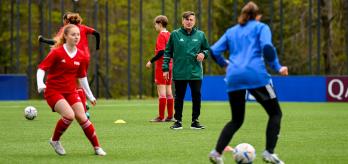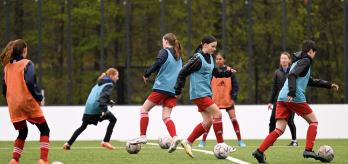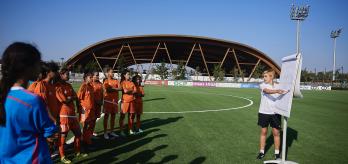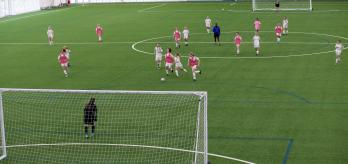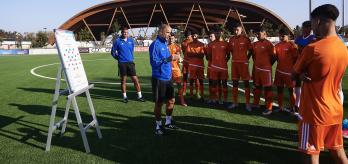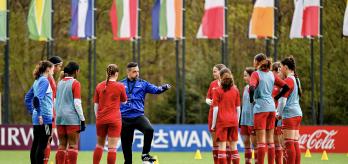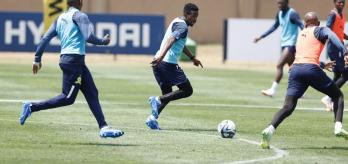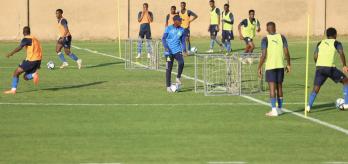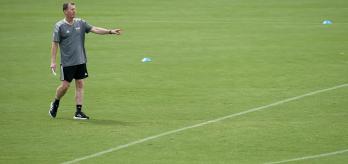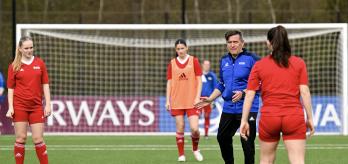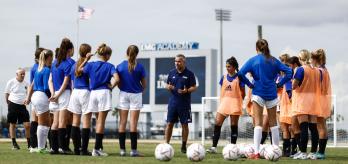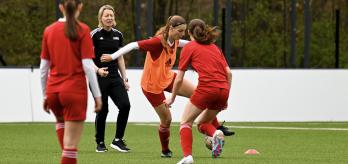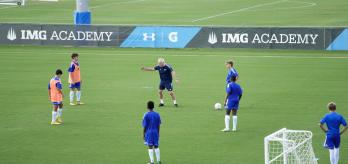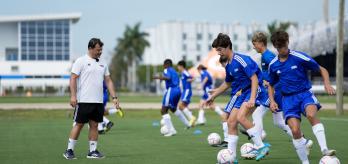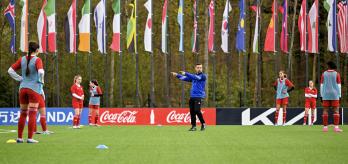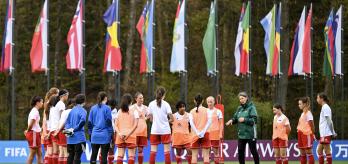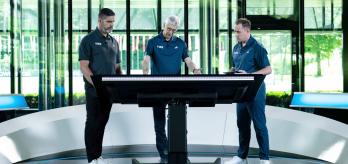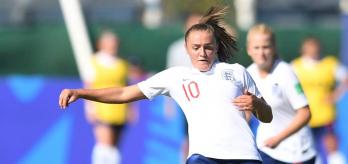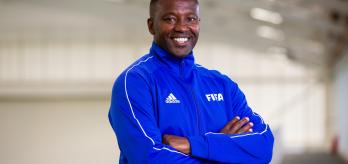In order to combine and play in tight areas, players must be comfortable on the ball, even when marked tightly. They must also move intelligently off the ball to exploit space, lose their markers or drag them out of position to create space for a team-mate, and they must be able to play accurate passes into feet or space. Collectively, the team must understand the importance of using the whole width of the pitch to stretch the opponent’s defensive block and create gaps in central areas.
In this session, Abdelouahed Zamrat, U-21coach at the Mohammed VI Football Academy, takes a group of players through a series of training drills aimed at developing their ability to retain and progress possession in the final third to create goalscoring opportunities.
The session begins with a technical warm-up which progresses into an opposed possession game. It is then followed by an unopposed drill involving passing and movement patterns. The third part is an attack v. defence game, which builds on the previous exercise by introducing opposition while maintaining an overload in favour of the team in possession. Finally, the session ends with a 9v9 game where players will have a chance to put all the learning points from the rest of the session into practice in a game situation.
Session overview
Key coaching points
-
Players should time and coordinate their runs off the ball to either create space for themselves or for a team-mate and allow forward play.
-
Receiving the ball in an open body posture is essential to be able to play forward quickly, either with a pass or by dribbling into space.
-
Quick combinations of play such as one-twos, up-back-throughs, overlaps and underlaps are very efficient ways to penetrate and disorganise defences so that a path towards goal can be found.
-
Players should support their team-mate on the ball to give them options and create overloads which can then be exploited to penetrate the opposition.
-
The attacking team should understand the importance of using the width of the pitch to stretch the opposition and create gaps in central areas through which to attack.
Part 1: technical practice and possession game
The warm-up begins with a series of dynamic activation movements that players perform after every pass they make. Players are then split into groups of three, with one ball per group. Within their group, players complete passes and combinations such as third-player runs, overlaps or up-back-throughs. The warm-up then evolves into a possession game in which two teams of six try to keep the ball against a third team of six.
-
Mark out an area the width of the penalty area and from the halfway line to the edge of the penalty area in length.
-
Split 18 players into 3 teams of 6.
-
3 balls are in play at the same time.
-
1 ball per team.
-
Players pass the ball and must complete dynamic warm-up movements (knee lifts, side steps, etc.).
-
Split the players from each team into groups of 3 and give each group a ball. Players then pass the ball around before they decide to combine between the 3 groups. The players can choose the combination, but it needs to involve third-player runs, overlaps, underlaps, etc.
-
Keep only 1 ball in play. 2 teams try to keep possession against the third team. If a team loses the ball, they switch roles with the defending team.
-
Players are encouraged to move the ball quickly with 1 or 2 touches.
-
During the possession game, players are encouraged to spread across the area to use as much of the space as possible and create gaps to find passes through the centre of the pitch.
Part 2: unopposed passing and movement patterns
This drill allows the players to rehearse different passing circuits and movement patterns in unopposed situations so that they can focus on the execution. Players are positioned to replicate the shape of a team set up in a 4-4-2 formation, but attacking in a 4-2-4 formation with right and left midfielders positioned high and wide. To give players a better idea of what the situation would look like in a game, Zamrat uses mannequins to represent a back four and a midfield two.
-
Use 1 full half of a pitch.
-
Use 4 mannequins to represent a back 4, positioned 8 metres in front of the penalty area.
-
Use 2 mannequins to represent a pair of central midfielders positioned 15 metres in front of the back 4.
-
Use 2 poles to represent 2 wide midfielders.
-
Use 2 poles to represent 2 centre-forwards positioned 15 metres in front of the midfield 4.
-
Organise the attacking team in a 4-2-4 formation.
-
Distribute the players so that they are doubled up in every position except the back 4 (2 forwards x2, 2 wide players x2 and 2 central midfielders x2).
- Each pattern and variation is completed with a specific sequence that involves two actions. The first action starts from the right side of the pitch and is then repeated from the left side of the pitch (pattern 1), and the second action is completed from the centre of the pitch (pattern 2). After a few repetitions of each pattern or variation, move to the next variation.
-
Players should time and coordinate their movements off the ball to make the attack as fluid as possible and confuse the opposition. Certain passes should trigger specific movements and players should be on the move while the ball is rolling to increase the amount of information the opponents need to consider when defending.
-
When moving to the centre from a wide area to receive the ball, players should adopt an open body shape, allowing them to receive on the half-turn if possible.
-
When playing forward and breaking lines, it is important that passes are played at a faster tempo to reduce the defence’s time to react and exploit the spaces.
-
Players are encouraged to make clever runs off the ball such as cross runs, rotations or overlaps to lose their markers and be free to receive the ball or attack the goal.
-
From the right side of the pitch, the centre-back (A1) plays a one-two with the right-back (B1).
-
B1 then plays into the right-sided centre-forward (C1), who comes short to receive.
-
C1 lays off the ball to the right-sided central midfielder (E1), who should have anticipated the pass by moving into the space in between the lines.
-
E1 then plays a first-time pass in between the 2 defensive mannequins and into the space out wide for the wide player (D1) to run onto.
-
D1 then crosses the ball into the area and, at the same time, the two forwards (C1, C2), the opposite wide player (D2) and the second midfielder (E2) make a run into the penalty area to finish the cross.
-
Repeat the sequence from the opposite side.
-
A1 and B1 play a one-two.
-
Instead of returning the ball, A1 carries the ball forward and, at the same time, D1 comes inside and B1 begins to make an overlap.
-
A1 plays the ball into D1.
-
D1 plays a first-time pass into E1.
-
E1 plays a first-time pass into the space for the overlapping run of B1.
-
Before B1 crosses the ball into the area, C1 and C2 should cross their runs so that C2 attacks the front post and C1 the penalty spot.
-
D2 should attack the back post, whilst E2 should make a run to the edge of the penalty area for any second balls.
-
B1 crosses the ball into the area for one of the attackers to finish.
-
Repeat the sequence from the opposite side.
-
A2 plays a one-two with B2.
-
B2 then plays into C2, who comes short to receive.
-
C2 lays off the ball to E2, who should have anticipated the pass by moving into the space in between the lines.
-
As C2 plays the ball into E2, the opposite winger (D1) should be making a run behind the mannequin that represents the left-back.
-
E2 passes first-time in between the 2 central mannequins and into the space ahead of D1.
-
D1 can either finish directly or cross for one of the runners to finish.
-
Repeat the sequence from the opposite side.
Additional variation: Players are free to come up with their own movements and combinations to create goalscoring opportunities.
-
The ball starts in the centre with the 2 central midfielders (E1 and E2).
-
E1 and E2 play a one-two.
-
Either E1 or E2 then passes into 1 of the forwards (C1 or C2).
-
The forward who receives the pass has to play a first-time through ball into the other forward, who should have timed a run to receive it behind the defence.
-
The forward has to finish by scoring.
-
Once the action in the centre finishes, start from the left side and vice versa.
-
Perform a few repetitions of these sequences.
-
E1 and E2 play a one-two.
-
E1’s return pass should be in front of E2.
-
As this pass is played, C2 drops deep to make a dummy run.
-
E2 makes a first-time pass behind the right-sided mannequin for C1 to run in behind and finish.
-
Repeat this sequence from the opposite side.
-
E1 and E2 play a one-two.
-
E1 plays into the feet of C2.
-
C2 then tees up E1 for a first-time shot on goal.
-
Repeat this sequence from the opposite side.
Additional variation: Players are free to come up with their own movements and combinations to create goalscoring opportunities.
Part 3: 10v8+goalkeeper – attack v. defence
In this drill, Zamrat coaches an attacking team of ten players to play through the final third and penetrate a defensive block made of eight defenders plus a goalkeeper. Players are encouraged to replicate the combinations and movement patterns rehearsed in the previous drill to combine and break through the defending team to create goalscoring opportunities.
-
The drill uses half a pitch plus an additional 10 metres in length and the full width of the pitch.
-
The wide areas are marked with white cones and are aligned with the width of the penalty area.
-
A horizontal line 7 metres from the edge of the penalty area is marked out.
-
The attacking team are set up in a 4-4-2 formation.
-
The defending team are set up in a 3-3-2 formation plus a goalkeeper.
-
Once both teams are comfortable and have understood the drill, the defending team are allowed to defend behind the red line.
-
The attacking team are also encouraged to complete 5 passes before trying to penetrate and play behind the red line.
-
The attacking team need to score within 10 seconds.
-
Players are encouraged to play one or two touches as much as possible to maintain a high tempo and reduce the time that defenders have to think about their movements, thus increasing the chances of poor positioning and therefore creating space to exploit and penetrate towards the goal.
-
When on the ball, players (especially the centre-backs) are encouraged to pass to the furthest team-mate possible to create opportunities to combine and exploit space. For example, when playing into a wide area, passing directly to the winger instead of the full-backs will give the latter the opportunity to make overlapping runs to attack the space behind the defence.
-
The attacking team should look to make the pitch big by positioning themselves across the whole width of the pitch to stretch the opposition, but also to allow switches of play once the opposition have been attracted towards one side of the pitch and an overload is created on the other side.
-
Players should look to create triangles around the ball to drag opponents out of position and create space to exploit in behind the defensive line by combining through one-twos and up-back-throughs, as well as using clever movements off the ball such as overlaps, underlaps and/or third-player runs.
8v8+goalkeepers – small-sided game
The session finishes with a 9v9 small-sided game that gives players the chance to implement all elements practised in the previous exercises in a match situation. At this stage of the session, players should be able to combine and penetrate through the final third with a high success rate and with limited input from the coach. To relate the drill to the 4-4-2 formation the team use on a matchday, Zamrat sets up both teams in a 3-3-2 formation.
-
The drill uses half a pitch plus an additional 10 metres in length and the full width of the pitch.
-
Position 2 full-size goals at each end of the pitch.
-
Mark out a red halfway line with orange cones.
-
Mark the wide areas with white cones aligned with the width of the penalty area.
-
Both teams are set up in a 3-3-2 formation.
- Players are limited to 3 touches in their own half.
-
Players are reminded to exploit overloads when they happen. When in a 2v1 situation, the player on the ball should drive towards the defender to put pressure on them and entice them so that their team-mate is freed up and can then be released into space.
-
Players are encouraged to play quickly so that any space created can be exploited before the opposition has time to recover its defensive positioning and close down the space.
-
Players around the ball should constantly look for deep forward runs in behind the defence to create opportunities to play through the opposition’s defensive block. When marked, they should try to use clever and synchronised movements, such as those worked on in the first exercise, to lose their marker.
-
Communication is important to let team-mates know where the space is and where a pass should be played. Players should communicate using both verbal and non-verbal cues, depending on the situation.
















